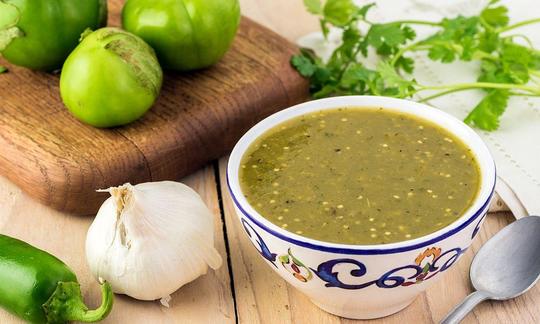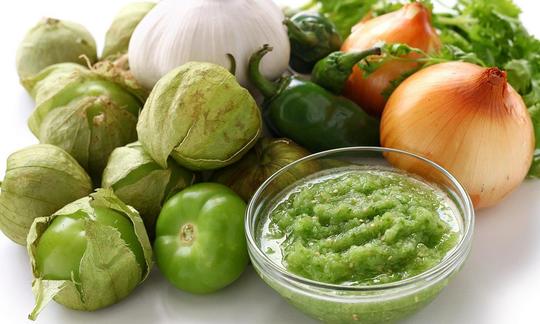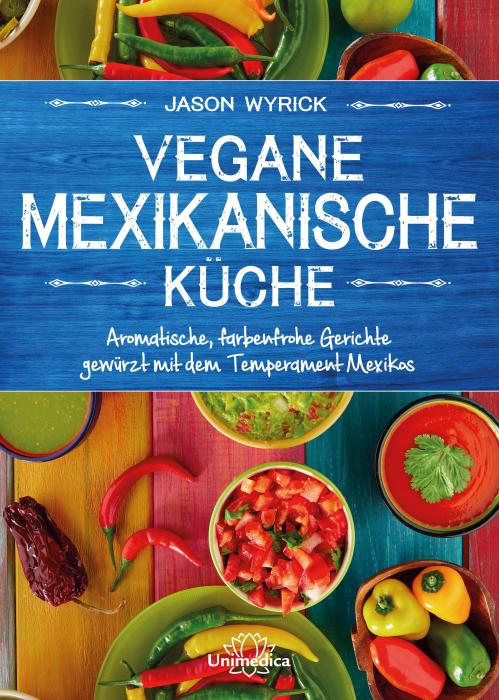Salsa verde made from pointed peppers and tomatillos
vegan
Ingredients (for servings, )
| 5 | Pointed peppers (Hungarian, raw, organic?) (18 oz) |
| 8 | Tomatillos (mountain aubergines), raw, organic? (9.6 oz) |
| ½ | Onions, raw (organic?) (1.9 oz) |
| 2 cloves | Garlic (organic?) (0.21 oz) |
| 2 bunch | Coriander leaves, raw (1.4 oz) |
| 2 tbsp | Epazote, raw (organic?) (0.06 oz) |
| 1 dash | Table salt (table salt, raw?, organic?) (0.01 oz) |
| 60 ml | Drinking water, raw (organic?) (2.1 oz) |
Equipment
- stove
- saucepan
- potato ricer or potato masher
Type of preparation
- cook
- chop or grind
- remove the skin
Preparation
Remove the stems from the pointed peppers and then roast the peppers in the pan, chop roughly and set aside.
Remove the fruit husks from the tomatillos and chop the tomatillos finely. Finely chop the onion, garlic, cilantro and epazote.You can prepare the salsa verde in advance or continue with other recipe steps while you prepare it.
In the original recipe, the author specified Poblano Chiles, which is a mild to only slightly hot cultivated form of the Capsicum annuum pepper species, similar to pointed peppers, and is grown primarily in Mexico. Jason Wyrick uses a medium-sized yellow onion as the onion.
Put all prepared ingredients, except the pointed peppers, together with salt and water in a 2-litre pot and simmer over medium heat for 7-8 minutes.
The original recipe calls for ¾ teaspoon of salt, which we have reduced to a pinch.
Once the tomatillos are tender, mash them with a heavy wooden spoon or potato masher to release more juice. Add the pointed peppers and simmer for another 2 minutes.
Serving size: Preparing this salsa verde with ingredients for 10 servings will yield about one liter of sauce.
|
Nutritional Information per person
Convert per 100g
|
2000 kcal | |
|---|---|---|
| Energy | 27 kcal | 1.4% |
| Fat/Lipids | 0.51 g | 0.7% |
| Saturated Fats | 0.06 g | 0.3% |
| Carbohydrates (inc.dietary fiber) | 5.8 g | 2.2% |
| Sugars | 3.1 g | 3.5% |
| Fiber | 1.2 g | 5.0% |
| Protein/Albumin | 0.85 g | 1.7% |
| Cooking Salt (Na:18.7 mg) | 48 mg | 2.0% |
| Essential micronutrients with the highest proportions | per person | 2000 kcal | |
|---|---|---|---|
| Vit | Vitamin C (ascorbic acid) | 51 mg | 64.0% |
| Vit | Vitamin K | 20 µg | 27.0% |
| Vit | Vitamin B6 (pyridoxine) | 0.29 mg | 21.0% |
| Vit | Vitamin B9, B11 (Folate, as the active form of folic acid) | 32 µg | 16.0% |
| Elem | Potassium, K | 206 mg | 10.0% |
| Min | Copper, Cu | 0.09 mg | 9.0% |
| Min | Manganese, Mn | 0.18 mg | 9.0% |
| Vit | Vitamin B3 (Niacin) | 1.1 mg | 7.0% |
| Vit | Vitamin B1 (Thiamine) | 0.06 mg | 5.0% |
| Min | Iron, Fe | 0.49 mg | 4.0% |
Detailed Nutritional Information per Person for this Recipe
The majority of the nutritional information comes from the USDA (US Department of Agriculture). This means that the information for natural products is often incomplete or only given within broader categories, whereas in most cases products made from these have more complete information displayed.
If we take flaxseed, for example, the important essential amino acid ALA (omega-3) is only included in an overarching category whereas for flaxseed oil ALA is listed specifically. In time, we will be able to change this, but it will require a lot of work. An “i” appears behind ingredients that have been adjusted and an explanation appears when you hover over this symbol.
For Erb Muesli, the original calculations resulted in 48 % of the daily requirement of ALA — but with the correction, we see that the muesli actually covers >100 % of the necessary recommendation for the omega-3 fatty acid ALA. Our goal is to eventually be able to compare the nutritional value of our recipes with those that are used in conventional western lifestyles.
| Essential fatty acids | per person | 2000 kcal |
|---|---|---|
| Linoleic acid; LA; 18:2 omega-6 | 0.23 g | 2.0% |
| Alpha-Linolenic acid; ALA; 18:3 omega-3 | 0.01 g | 1.0% |
| Essential amino acids | per person | 2000 kcal |
|---|---|---|
| Tryptophan (Trp, W) | 0.01 g | 2.0% |
| Threonine (Thr, T, irreversibly transaminated) | 0.02 g | 2.0% |
| Isoleucine (Ile, I) | 0.02 g | 1.0% |
| Leucine (Leu, L) | 0.02 g | 1.0% |
| Lysine (Lys, K, irreversibly transaminated) | 0.02 g | 1.0% |
| Methionine (Met, M) | 0.01 g | 1.0% |
| Phenylalanine (Phe, F) | 0.02 g | 1.0% |
| Valin (Val, V) | 0.02 g | 1.0% |
| Vitamins | per person | 2000 kcal |
|---|---|---|
| Vitamin C (ascorbic acid) | 51 mg | 64.0% |
| Vitamin K | 20 µg | 27.0% |
| Vitamin B6 (pyridoxine) | 0.29 mg | 21.0% |
| Vitamin B9, B11 (Folate, as the active form of folic acid) | 32 µg | 16.0% |
| Vitamin B3 (Niacin) | 1.1 mg | 7.0% |
| Vitamin B1 (Thiamine) | 0.06 mg | 5.0% |
| Vitamin A, as RAE | 36 µg | 4.0% |
| Vitamin E, as a-TEs | 0.44 mg | 4.0% |
| Vitamin B2 (Riboflavin) | 0.05 mg | 3.0% |
| Vitamin B5 (Pantothenic acid) | 0.18 mg | 3.0% |
| Vitamin B7 (Biotin, ex vitamin H) | 0.23 µg | < 0.1% |
| Essential macroelements (macronutrients) | per person | 2000 kcal |
|---|---|---|
| Potassium, K | 206 mg | 10.0% |
| Magnesium, Mg | 15 mg | 4.0% |
| Phosphorus, P | 30 mg | 4.0% |
| Calcium, Ca | 14 mg | 2.0% |
| Sodium, Na | 19 mg | 2.0% |
| Essential trace elements (micronutrients) | per person | 2000 kcal |
|---|---|---|
| Copper, Cu | 0.09 mg | 9.0% |
| Manganese, Mn | 0.18 mg | 9.0% |
| Iron, Fe | 0.49 mg | 4.0% |
| Zinc, Zn | 0.25 mg | 2.0% |
| Selenium, Se | 0.44 µg | 1.0% |
| Fluorine, F | 4.6 µg | < 0.1% |
| Iod, I (Jod, J) | 0.12 µg | < 0.1% |
Narayana Verlag GmbH /Unimedica Verlag , Jason Wyrick
Raw recipes 21 (1), Cooked recipes 117 (3)
Additional photos (4)
"Vegan Mexican Cuisine – Aromatic, colorful dishes seasoned with the temperament of Mexico" provides a comprehensive insight into Mexican cuisine.
Since this book is written in German, a description is omitted here. If you are interested, please switch to German in the menu.
The Mexican salsa verde made from tomatillos and pointed peppers (originally with green "poblano chiles") is not to be confused with other green sauces.
Serving size: Preparing this salsa verde with ingredients for 10 servings will yield about one liter of sauce.
Nutrient profile: For the recipe " Plantain Tacos with Red Cabbage " 30 grams of salsa verde are used per person. According to GDA guidelines, this covers around 40% of the average daily requirement of vitamin C and around 10% of vitamin A. The ratio of omega-6 to omega-3 fatty acids is not particularly important in this recipe in terms of quantity, unless you consume more than 120 grams. Information on a recommended ratio and generally useful tips can be found under the following link: Vegans often eat unhealthily. Avoidable nutritional errors.
Tomatillo: The tomatillo ( Physalis philadelphica), which also grows wild, is a plant species of the Physalis genus. Since there are also purple varieties, it is sometimes known as mountain eggplant. The original home of the tomatillo is Central America and Mexico. Although tomatillos are mainly cooked or grilled and used in mixed vegetable dishes, they can also be eaten raw.
Mexican gland goosefoot (epazote):
In Europe, the Mexican goosefoot is known primarily as epazote. In addition to being used as a spice or, more rarely, as a leaf vegetable, the leaves are also used to make herbal or medicinal tea. The herb is preferably used fresh, as it loses its aromatic diversity when dried. Raw, epazote has a slightly sharp taste with a resinous, ethereal note, similar to oregano, anise, fennel or tarragon, only much stronger. However, an overdose leads to dizziness, vomiting, etc., so raw leaves should only be consumed in moderate amounts. More precise information is not known, as the ingredient responsible for the toxicity, ascaridol, in the leaves can amount to between 0.8-1% of the dry weight, depending on the environmental conditions. In a Spanish study, 1 gram of ascaridol is given as a potentially lethal dose, but without more precise information. Even under the worst conditions (1% per leaf and 1 gram as a lethal dose), at least 100 g of dry (about 900 g fresh) leaves would be necessary for lethal intoxication.
Difference to other "green sauces":
In addition to the well-known Salsa Verde in Mexico, there are also green herb sauces in Italy under the same name. The best known is pesto. In northern Italy there is a Salsa Verde that is traditionally served with Bollito misto; the dish is very similar to Frankfurt sauce with egg and mustard. Bagnetto verde is also a green herb sauce that is thickened with boiled egg yolk and breadcrumbs and refined with parsley. The use of tomatillos is only known in Mexican Salsa Verde.
Storing Tomatillos: Ripe, undamaged Tomatillos can be stored at room temperature for up to a week. Longer storage is possible at 5-10 °C. However, cold damage begins to appear after 2-3 weeks at 5 °C and after 3-4 weeks at 10 °C.






